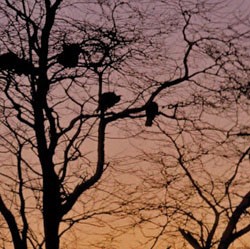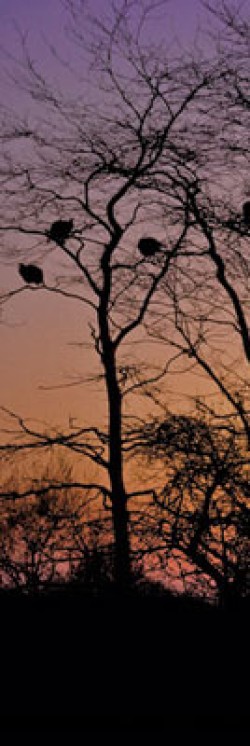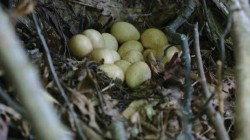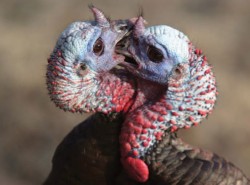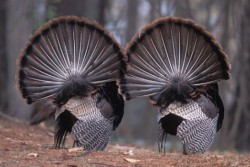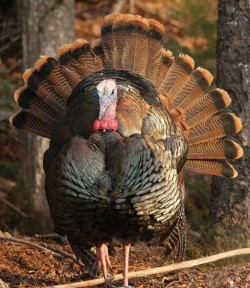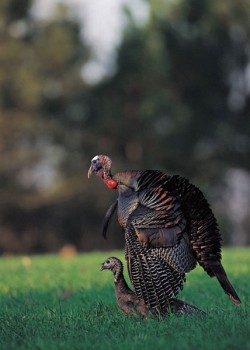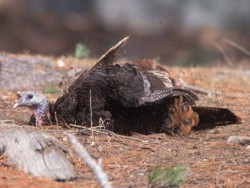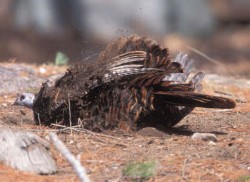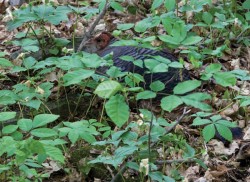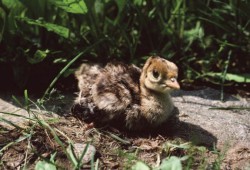Chokolokaloka.
There are so many bird sounds in a spring forest, it can be hard to pick out just one.
Chokolokaloka.
But he’s there – hear him? A male (“tom”) turkey. And he’s just left the roost.
There’s nothing musical in the tom’s gobble – it sounds sort of like a sack of hard syllables rolling down a stairwell. The hens’ come-hither pleadings, those raspy “keow-keow-keows” that hunters replicate by scratching a wooden point against a slab of slate, aren’t much prettier. And yet whatever this mating ritual lacks in auditory aesthetics, it more than makes up for in transfixing visual power.
A mature tom turkey is the largest native gamebird in North America, and a spring forest has a way of deferring to his presence. Chokolokaloka. See him now as he swaggers into the middle distance, his shocking red head in sharp contrast against his charcoal-colored feathers.
You wouldn’t call a turkey graceful, especially in flight, where they’re famous for crashing haphazardly through the forest canopy. On the ground, where they spend most of their time, they lumber like dinosaurs, their considerable mass jerking awkwardly on spindly legs.
And yet a tom in display seems fluent and weightless. As he approaches a hen, he seems to throb, his feathers rippling with sexual urgency. Suddenly amber-striped tail feathers appear and rise to form a perfectly symmetrical fan. As his fan goes up, white-flecked wing tips drop to obscure his feet so that when he moves, it appears as though he’s gliding on air.
That these magnificent birds are even here – gracing our forests and fields – is a fact that can’t be trumpeted enough. Precolonial estimates peg wild turkey populations somewhere between 7 and 40 million birds. By the early 1900s, there were only 30,000 left in the whole country. The bird had, by all practical measurements, completely disappeared in the Northeastern states.
What followed was a remarkable ecological success story, as state and federal wildlife agencies were able to bring the wild turkey back from the dead. New York started things off in 1957, when they moved a few birds from Allegany State Park to other parts of the state. The new birds took, and in 1969, both Vermont and New Hampshire live-trapped New York birds and began reintroduction programs of their own. In 1977, Maine followed suit. These initial reseeding efforts were enhanced by habitat improvement work and stocking efforts undertaken by a variety of conservation and hunting groups – notably, the National Wild Turkey Federation, a membership and volunteer-based organization with chapters throughout the Northeast.
Today, there are thought to be roughly 90,000 turkeys in Vermont, New Hampshire, and Maine combined. The New York population is estimated at 250,000 to 300,000. In the U.S. as a whole, the population numbers around 7 million birds.
The tom stands before you now – 50 feet away – his head aglow with otherworldly shades of red, white, and blue; his keen, black doll eyes scanning the woods before him. And then, all at once, the fan collapses, and the guttural, aggressive gobble is replaced by an alarmed “tut, tut, tut.” The tom turns and snakes – low to the ground – back the way he came. Who knows how he saw you, motionless and camouflaged against a blowdown – maybe the glint of the morning sun against the copper eyelets on your boots, maybe even the whites of your eyes. But the show’s over. One moment a tom turkey dominates a forest glen, the very personification of animal Eros and power. And then, just like that, he disappears.


